In art at all times and among different nations there is a motif of depicting an ideal, in the opinion of the authors, city of the future. This image can be formed under the influence of science fiction literature, drawings, technological progress.
At the end of the 19th and beginning of the 20th centuries, the city of the future was a majestic urban landscape with huge skyscrapers, a developed transport system, and numerous factories and plants.
It was at this time that the first high-rise buildings were built in England, the USA and Germany, which led to the popularity of the topic of high technology and broad prospects for the development of urban space.
With the development of space themes in the second half of the 20th century, images of settlements in space, inspired by real research, popular science literature and films, began to dominate popular culture.
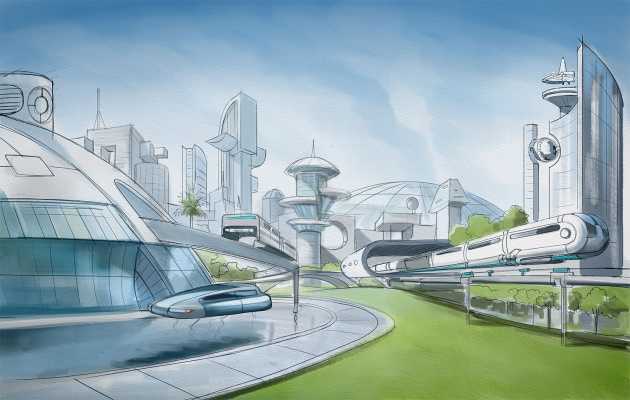
The city of the future was imagined as an interplanetary complex using the resources and advantages of space stations and orbital cities with their own closed ecosystem. The end of the 20th - beginning of the 21st century was marked by the development of information technology.
Modern scientists imagine the city of the future as a complex system of “smart” houses and cities, where all functions – from energy supply and security to organizing transport and waste disposal – are maximally automated and effectively regulated by artificial intelligence.
Necessary materials and tools
Artists use a variety of tools and materials in the process of creating their works. To understand their functions, capabilities and meanings, it is necessary to study each of them separately.
| Tools and materials | Brief description |
| Paper | Different types of paper are suitable for drawing, including watercolor, pastel and pencil drawing. It is usually marked by density: it can be thick 200-300 g/m² or lighter - 160-180 g/m². |
| Pencils | Graphite (or simple) pencils have different degrees of hardness: from the hardest (9H) to the softest (9B). Soft pencils are convenient for making dark areas, and harder ones - light ones. The thickness of the graphite rod can be different. |
| Erasers | They are used to erase incorrectly executed or unwanted elements of a drawing. Erasers can be made of different materials and have different sizes and shapes. Some types are designed for delicate erasing, others for intensive impact on the surface of the paper. |
| Klyachki | It is a soft material that can be used to lighten or change the intensity of certain areas of a drawing. It allows the artist to make changes to the composition and achieve the desired depth of tone. |
| Stencils | This is a device for applying repeating elements or patterns to paper. It can be useful when creating serial designs or decorations. Stencils are available in various shapes and sizes depending on the desired artistic effect. |
| Rulers, compasses | During the drawing process, they can be used to create straight lines or scale elements of the composition. |
| Sharpeners | Designed to correct the sharpness of hard tools such as pencils. With this tool, the artist can maintain the tool in working order and ensure the clarity of the lines. |
All of the above materials can be used separately or in combination with each other to achieve the desired effect.
Master classes
In the process, you can use a variety of lines and shapes to create a cosmic, industrial or other futuristic space. Lines can show both an architectural landscape and an atmosphere of technological takeoff.
With unusual architecture
The city of the future in the picture can be created if you follow the sequence of steps and pay attention to every detail.
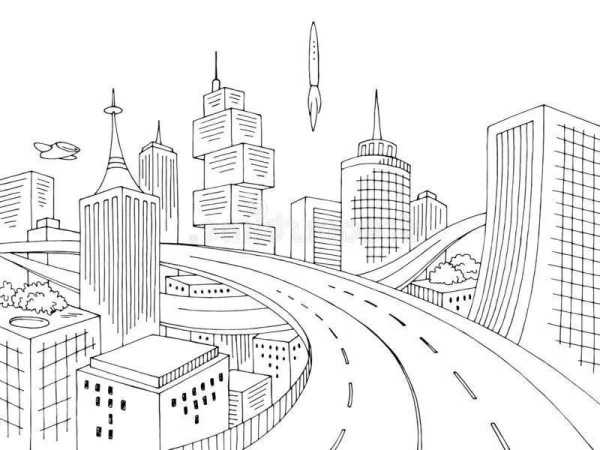
It is depicted in a futuristic style, including unusual buildings and vehicles in the picture:
- Start by sketching the basic outline of the city. Create a composition with the general shapes of buildings, roads and other city elements. This will help you plan the placement of objects and understand the overall structure. Use simple shapes to create the outline of the city.
These can be squares, triangles, circles or other geometric shapes. Use simple lines to create basic contours. At this stage, do not go into detail, but convey a sense of space and proportions.
- Start by drawing the main highways and roads in the city of the future. They can have unusual shapes, such as multi-level or spiral or curved paths.
Draw a road that starts in the lower right corner and curves upward to the upper left corner. It can be drawn as a wavy line to give it a dynamic look. It is the central element of the composition, creating a sense of height.
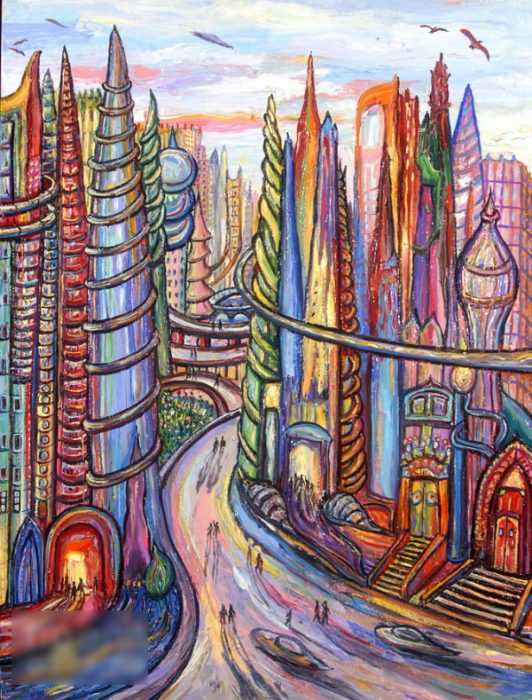
When depicting a road, consider not only its geometry, but also the nature of traffic on it, possible interchanges and changes in width.
- From the top left corner, draw a second road going down. It is curved, which will add volume and dynamics to the city. The lower road can be smaller or less noticeable than the upper one to create contrast and a sense of perspective.
- Place unusually shaped buildings on the drawing. Create skyscrapers that will look unusual and fantastic. You can add unusual shapes, curves and structures. For example, they can be round, oval or even pyramidal.
Use different lines and strokes to create the impression of volume and depth of buildings. You can use smooth lines and asymmetrical shapes to create a futuristic effect.
As they move away from the viewer, the buildings should become smaller and more schematic.

- Add a rocket, which will symbolize progress and aspiration for the future. It can be placed in the center of the composition or against the background of other buildings. The rocket should look dynamic and strive upward.
- Add flying machines – from small drones to huge spaceships. Draw them using lines and strokes to highlight the design features. You can draw both city flying taxis and cargo flying ships.
- Detail the roads. Add small details such as medians, walkways or bridges over bodies of water. Use different types of lines to convey movement, variety of shapes and textures.
This will help create the impression of dynamism and modernity in the city.
- Detail the buildings. Pay attention to their unusual shapes: domes, complex curves. Depict architectural details that will make the city unique: spires, domes, balconies or unusual roof structures.
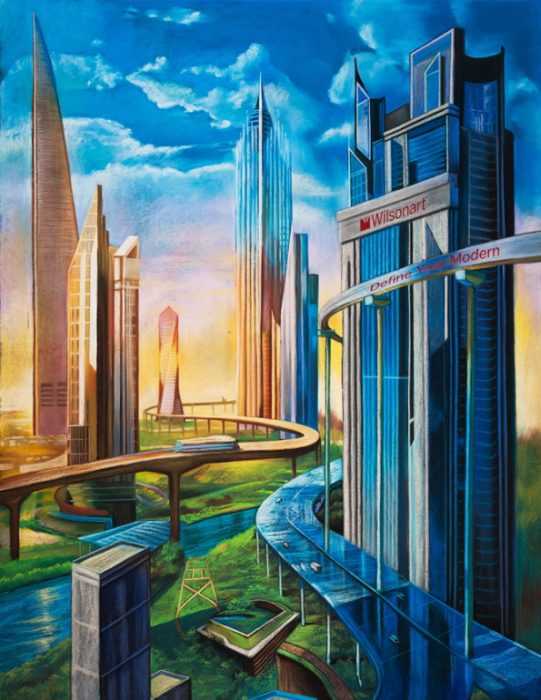
Add natural elements such as bushes or trees on rooftops to highlight the connection between the city and the surrounding environment.
- Remove unnecessary lines to clean up the composition and make it clearer.
- Trace the outlines of buildings, roads and aircraft with a soft black pencil.
- Color the picture. Choose colors that match the atmosphere of the city.
In cartoon style
The city of the future can be depicted in the picture with the help of a master class, which presents general recommendations and is not a strict guide to action:
- Determine what main elements will be included in the drawing. These are buildings of unusual architecture, futuristic cars, traffic lights, clouds and other details. Draw a simple outline of these elements on paper.
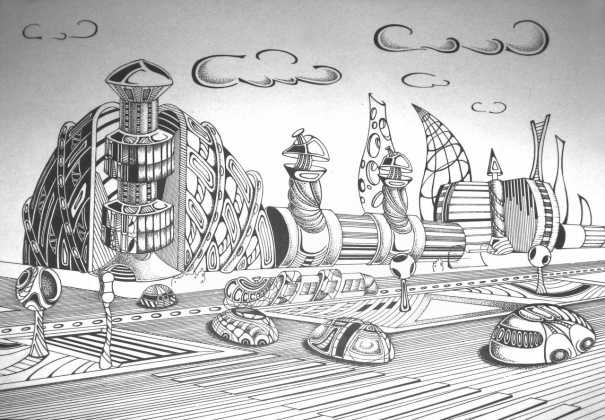
Use simple shapes such as circles, triangles, squares and rectangles to sketch. These shapes can be combined to create unique shapes.
When creating a sketch, it is recommended to select one or more dominant lines and shapes that will determine the structure and mood of the drawing. Provide for unusual angles of buildings and their location relative to each other, creating an interesting and dynamic composition.
- Start drawing roads. In the city of the future, they can be made in different forms, for example, in the form of bridges or tunnels laid above or below the surface of the earth.
Interactive elements such as moving platforms or self-propelled sidewalks can be added to give the roads a special character. They should create a sense of speed, futurism and forward movement.
This can be achieved by adding perspective effects or using contrasting colors to depict light and shadow.
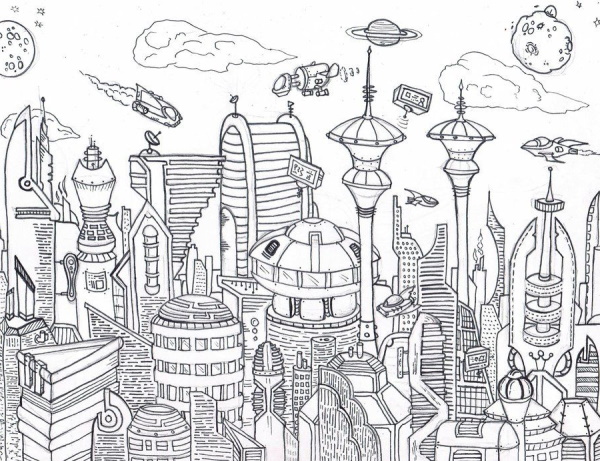
- Create buildings with futuristic architecture using simple geometric shapes. Building design can reflect future developments in technology and materials.
These can be tall skyscrapers in the shape of geometric figures, spherical structures or houses that seem light and airy due to their transparency.
Pay attention to details such as windows, doors, antennas and other elements that make the building unique. Cartoon style involves bright and saturated colors, so feel free to use contrasts. Buildings should be different from each other.
- Draw cars. These can be flying cars, vehicles with unusual shapes and designs that reflect advanced technologies and innovations. Pay attention to the details: wheels, windows, doors, headlights.
To avoid going overboard with colors, concentrate on 1-3 cars that will become the main accents of the drawing.

- Draw traffic lights, which can have an unusual design or shape that differs from the usual modern ones. Add decorative elements to the light signals.
It can be a complex geometric pattern or abstract symbols that symbolize technology and progress.
- By adding clouds, you can create a future atmosphere where technology and nature coexist. Clouds can be unusually shaped or reflect light from buildings.
- Remove unnecessary lines and details to make the drawing clearer.
- Trace the outlines of all the elements to give the image a clearer shape.
- Add shadows and volume using various shading and blending techniques. To achieve the effect of volume, you can use darker shades for shadows and lighter ones for light areas.
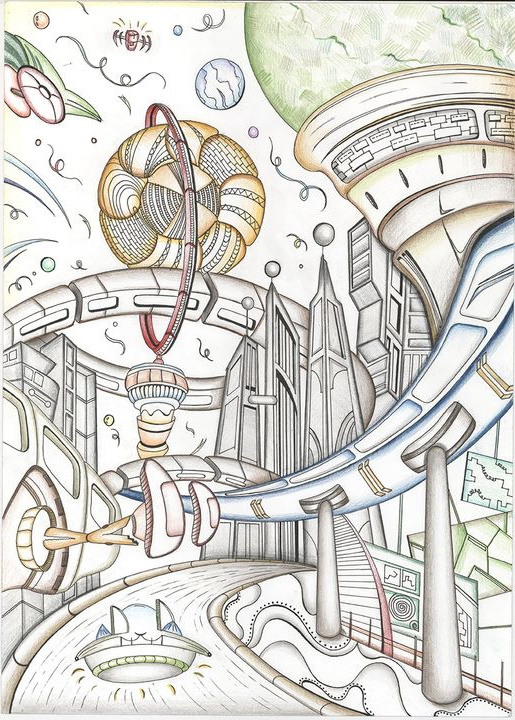
Maintain proportions and sizes of details to create a harmonious and aesthetically pleasing image.
Schematic representation
The city of the future in the drawing in schematic form can be depicted by following these steps:
- Create a sketch of the main elements of the city. This is a simple outline of buildings, roads and other infrastructure. It is important to determine the scale and location of key elements.
- Draw the main transport arteries of the city: streets, avenues, highways. You can use simple geometric shapes to represent roads, such as straight lines or curved arcs.
- Sketch unusual futuristic architecture buildings. They can have unusual shapes such as spirals, domes or parabolas. Use simple lines and shapes to create the outlines of the buildings.
- Add an important element of the city landscape - the Moon. It can serve as a source of light for the night city or reflect its night atmosphere. Draw it at the top of the drawing.
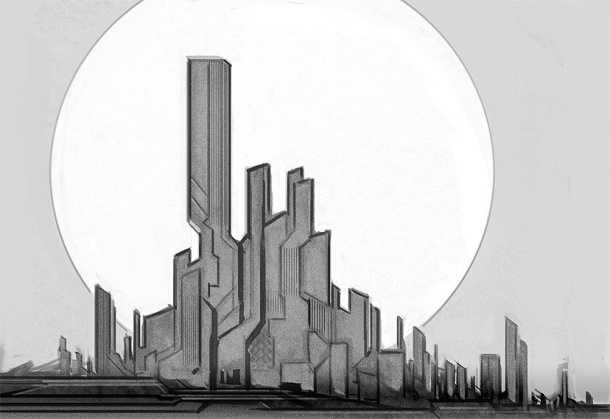
- Remove unnecessary lines to make the drawing clearer.
- Outline all the elements of the drawing using thicker and clearer lines to give them volume.
- Add volume and shadows to create the effect of depth and space. Start with the shadows of the buildings, and then move on to shading the buildings and roads themselves. Shade them evenly to achieve a smooth transition between light and shadow.
Eco-city with pastel pencils
The development of transport systems, the use of alternative energy sources, and green construction can lead to the creation of an “ecologically clean” city that fits harmoniously into the surrounding landscape.
Such a city will become high-tech, but at the same time ecologically balanced.
The city of the future in the picture can be created using the master class, which describes the stages of work in detail:
- Start with a simple pencil sketch. Determine the composition of the drawing: the location of buildings, roads, rivers and other elements. Think about what buildings will be in the city of the future and how they can be located.
The sketch should be light and neat, without pressing too hard on the pencil, so that changes can be made easily.
- Draw a building that resembles a sailboat using simple lines and shapes. It can be located in the foreground or in the center of the composition. Futuristic architecture implies unusual shapes and non-standard solutions.
- Add a few buildings to the background. They should be simple and laconic, but at the same time fit harmoniously into the overall appearance of the city. Use different sizes and shapes to create variety. Make the houses multi-story, add balconies and windows.
- Draw a river that will flow through the city. It can have a winding shape and different depths. Draw the banks of the river.
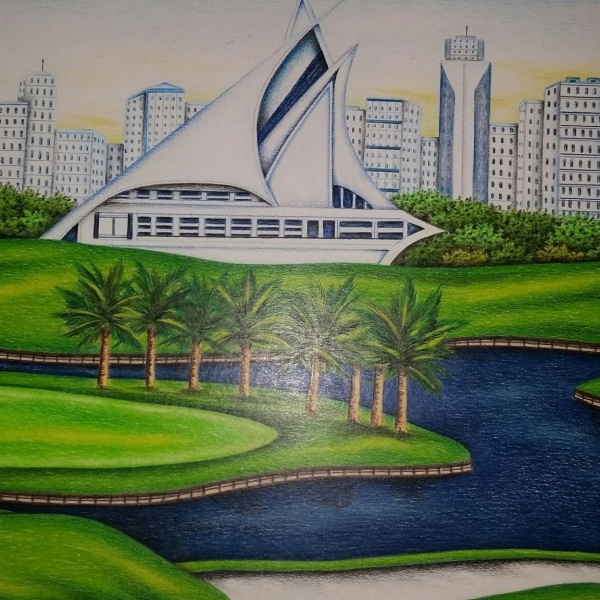
- Draw the road lines that will connect the buildings and other elements of the drawing. It should be wide and smooth to emphasize the scale of the city.
- Draw bushes around. They can be thin and graceful or thick and lush.
- Depict palm trees next to a river. They can be tall and slender or spreading and wide. Palm trees will add an exotic flavor.
- Remove all unnecessary lines and details that will not be visible in the final drawing.
- Give the building a unique look sailboat, for example, add decorative elements. Add windows to the buildings, making them neat and clean lines. highlight the window frames in blue.
- Use light shades of gray or white for the main outline of the building to make it stand out from the rest of the city. Detail the shape of the building by adding details and windows. Shade the colors so that the transitions are smooth.
- Work on the details of the buildings: balconies, doors, architectural elements, etc. This will give the drawing depth and richness. Color the rest of the houses in the drawing, using white to create the effect of light and shadow.
To give the city a finished look, use shades of blue and light blue for windows, doors and other small details.
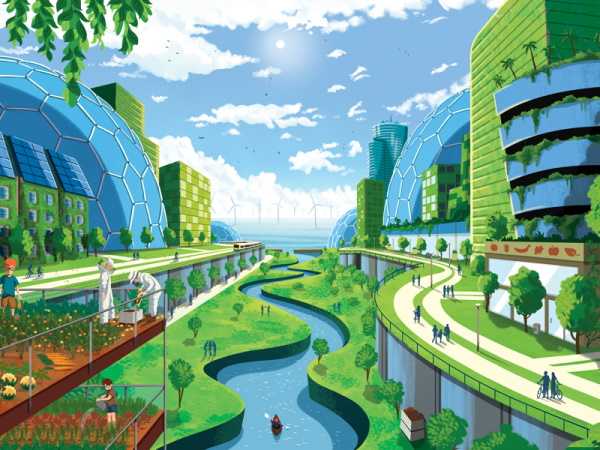
- Add shades of green and yellow to the bushes to highlight their lushness and brightness.
- Paint the palm trees, detailing the trunks with brown shades and the leaves with green and yellow.
- Draw the river using different shades of blue and light blue. The colors should smoothly transition into each other. Use several shades to give the river volume.
- Use pastel green pencils for the grass to make it look voluminous and natural. Add shades of green for shadows.
- Colour the road using pastel light brown pencils. It should be clearly visible against the background of the city landscape. Add shadows. Pay special attention to shading to achieve smooth transitions between colours and make the drawing more harmonious.
Tips for Beginners
The city of the future can be depicted in a drawing using recommendations that will help you start working on your own vision.
| Stages | Comments and recommendations |
| Style | Determine what style the city will be in to convey its futuristic look. For example, modern architecture with elements of cubism or postmodernism, a city with flying cars or a spaceship instead of a monument in the center. |
| Concept and idea | Formulate the main features of the city of the future. This could be high-tech, eco-friendly, futuristic, social features. Based on this, think through the details and elements of the drawing that will reflect the concept. Choose one idea and stick to it. You can’t embody too many ideas in one drawing – you get a chaotic pile of objects. |
| Composition and perspective | Use the laws of composition to create a harmonious image. Consider the relationship of shapes and sizes, perspective and scale. This will help make the drawing clearer and more understandable to the viewer. Create a balance between the main and secondary details. |
| Color scheme | Future cities can have bright colors with unusual combinations. Or you can create an atmosphere with a calmer, neutral palette, but use special shades of metallic, gold or silver. A variety of techniques will help convey the mood and characteristics of the city. |
| Detailing and textures | Carefully add small details and textures to give the drawing realism and depth. |
| Elements of Futurism | Come up with original building designs or unusual vehicles. You can add aircraft, monorail systems or high-speed trains. Pay special attention to futuristic elements that will reflect the future as you imagine it. |
| Details of modern cities | Even though the city is futuristic, it should still have a general resemblance to current reality. |
| Tonal elaboration and light/shadow | To add volume, use tonal elaboration and lines of light and shadow. This will give the drawing a planarity and dynamics. |
Drawings of fantastic cities of the future reflect the dreams and fantasies of artists. Such landscapes embody the latest architectural and engineering solutions, innovative technologies and futuristic lifestyles.
For an image, you need to think through ideas and details that will make it special and memorable.
Video about drawing
City of the Future - Drawing:
